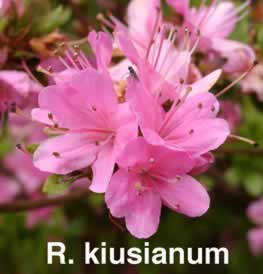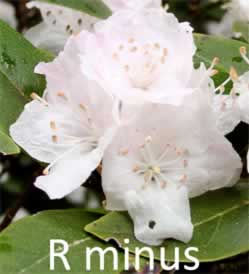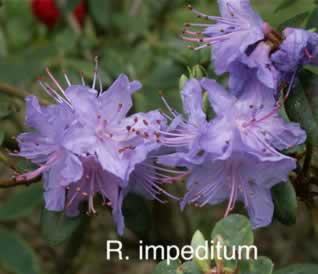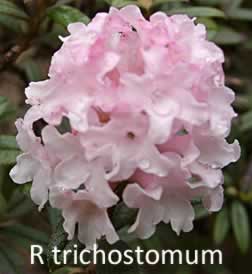
Rhododendron & Azalea News
Sun, Shade, & Heat Tolerant Rhododendrons & Azaleas
& Which Ones Are Cold Hardy
by Steve Henning
Valley Forge Chapter ARS
Most rhododendrons and azaleas do best when planted in areas with partial shade. That means areas with trees that cast shade with sun filtering through, or areas that are in shade part of the day and sun part of the day. The presence of sun light assures a good bud set; plants in full shade frequently don't bloom and frequently grow tall and lanky. The presence of part shade helps the plants fight insect pests and disease. For example, the natural predators of rhododendron and azalea lace bugs do not thrive in full sun. Root rot is much more prevalent on plants where the roots can't be kept cool. Usually plants that are infected with lace bugs will do much better if moved to areas with more shade. Plants prone to root rot stay healthier in areas where the soil is cooler and has good drainage.
I will explore varieties that are tolerant of shade, sun, and heat. I will find out which are also cold hardy. Then I will explore those that are tolerant of shade, sun, and heat, and are also cold hardy; what I call the Ironclads for the 21st Century. Most of this information is gleaned from Harold Greer's website and books. These are links to the various sections:
This section lists 19 rhododendrons that are not only shade, heat & sun tolerant, but also cold tolerant. Of these, 14 are also shade tolerant.
Shade Tolerant Rhododendrons and Azaleas
Rhododendrons and azaleas, which are among the most popular flowering plants for shade, are commonly thought to be, as a group, amenable to low-light conditions. In fact, all of them need some sun to produce flower buds, but some need more sun than others. In general, most Azaleas will grow very well if they receive four hours or more of bright sun per day. Rhododendrons will grow nicely in full sun to moderate shade. A few Rhododendron varieties such as Caroline', 'Scintillation', Yakushimanum hybrids, 'Hong Kong' and the hardy varieties from Finland must have some shade in midday or the foliage will yellow or even burn – especially during a hot summer. P.J.M. and 'Nova Zembla' are two of the most sun-hardy evergreen Rhododendrons.
Many varieties need shade to prevent lace bug infestations since the natural enemies of lace bugs are not active in sunny areas.
On the other hand, if shade is too dense, it can cause fewer blooms and spindly growth. Dense shade and poor air circulation can also be deadly to Rhododendrons. This combination can result in a dieback fungal attack on new plant growth and attack the plant branch by branch. The species and hybrids listed here bloom especially well in the minimal sun and bright light of open to medium shade, and two of them, Snowlady and the Royal Azalea, will even bloom in deeper shade. Despite their physical differences, rhododendrons and azaleas belong to the same genus and require the same growing conditions. The rhododendrons are all evergreen; ten of the azaleas are deciduous and one is evergreen. [Return to Top]
Hybrid Rhododendrons for Shade
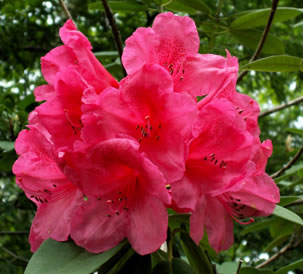 |
Anna Rose Whitney |
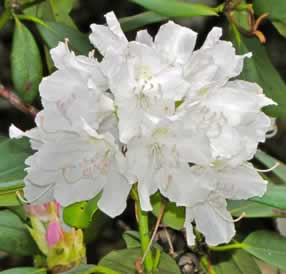 |
Boule de Neige |
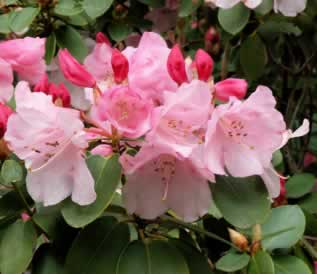 |
Bow Bells |
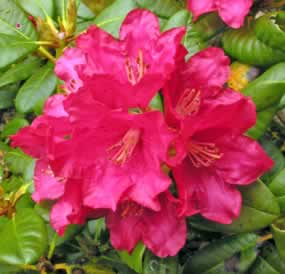 |
Elviira |
Anna Rose Whitney – 6 ft (1.8 m) -5°F (-21°C), LM. It is sun, heat, and shade tolerant. This plant grows quickly to form a very large, densely foliaged, well-shaped rhododendron. Deep rose-pink flowers are held in large, open trusses.
Boule de Neige – 5 ft (1.5 m) -25°F (-32°C), M. The name means “Ball of Snow” in French. As you might expect, the flowers are white, in perfect rounded trusses, and geometrically proportioned to the leaves. The habit is dome shaped. Leaves are matte green, and the plant's constitution is tough and very hardy. It grows to a height of 4' and width of 5'. It even blooms well in deep shade.
Bow Bells – 3 ft (.9 m) -5°F (-21°C), M. It forms a perfect mound of pink. The flowers are followed by shiny, copper colored new leaves. As the season progresses, the mound becomes a superb jade green with rose-red bud scales for another show of color. While growth at 10 years is 3 ft (.9 m), it will become a larger plant, so give it enough space. A site with filtered light is best for ´Bow Bells´. Fertilize lightly, as an excess of fertilizer will cause foliage burn more easily than on most rhododendrons.
Elviira – 2 ft (.6 m) -30°F (-34°C), L. This rhododendron is very hardy. It grows to a height of 2' and width of 18" to 24". It grows well in shade. A very low growing rhododendron cultivar. Densely branched, it is covered with flower buds that are hardy to -30F and open bright red. From the group of Marjatta hybrids developed at the University of Helsinki, Finland. [Return to List]
More Hybrid Rhododendrons for Shade
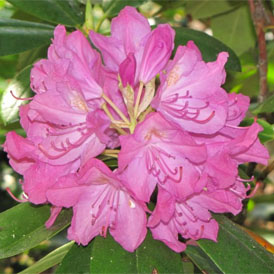 |
English Roseum |
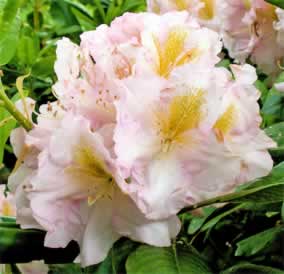 |
Janet Blair |
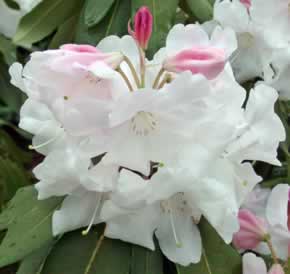 |
Loderi King George |
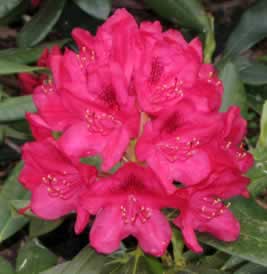 |
Nova Zembla |
English Roseum – 5 ft (1.8 m) -25°F (-32°C), LM. A soft rose pink, R. catawbiense hybrid, 6 feet or taller. A reliable 'iron-clad, English Roseum is sun, heat and cold tolerant to -25°F (-32°C). Tolerates shade well.
Janet Blair – 5 ft (1.5 m) -20°F (-29°C), M. 'Janet Blair' has large, fragrant, frilled lavender pink flowers fading to a pale center and topped off by a blotch of yellow rays on the upper lobes. The plant, with its glossy green foliage and mounding habit, is not only cold hardy but also heat tolerant. Blooms third week of May, and is better in moderate shade than most other varieties.
Loderi King George – 5 ft (1.8 m) 0°F (-18°C), M. This is a tall hybrid rhododendron that blooms in mid-spring, producing huge pale pink flower clusters that turn white as they mature. It generally grows 6 feet tall but may reach a height of 12 feet. With rhododendrons, the rule of thumb is that the larger the leaf, the less sun they can handle gracefully. 'King George' and other Loderi rhododendrons are large leaf plants that follow this rule. However, if given enough shade they are also drought tolerant.
Nova Zembla – 5 ft (1.5 m) -25°F (-32°C), M. This rhododendron has true hardiness in a red. A vigorous plant that has good foliage and will grow in more difficult areas. This hybrid exhibits some outstanding characteristics. Of course, hardiness tops the list. A nice looking contrast with other plants. Extremely showy, red flowers make a real display in the spring.. Dark red flowers in a ball-shaped cluster. Broad, bushy plant. Cold and heat tolerant and sun and shade tolerant. It grows to 5' tall and is hardy. [Return to List]
More Hybrid Rhododendrons for Shade
 |
Black Satin (PJM) |
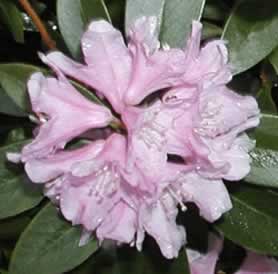 |
Desmit (PJM) |
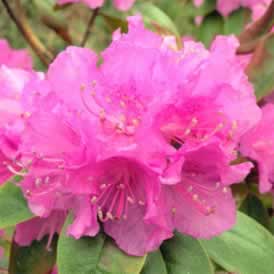 |
Elite (PJM) |
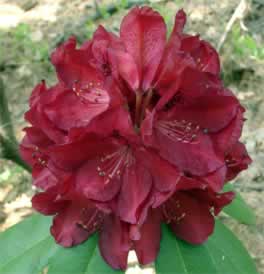 |
Henry's Red (PJM) |
P.J.M. hybrid rhododendrons. Rhododendrons in the 'P.J.M.' group are smaller, growing to a height of 3 to 5 feet tall. Form is rounded and the foliage is leathery and dark green until fall when it turns almost purplish. One of the reasons rhododendrons in the 'P.J.M.' group are such heavy bloomers is that the plants do not set seed. They are very hardy, among the hardiest and most shade tolerant rhododendrons. They include the following:
- Black Satin – 3 ft (.9 m) -20°F (-29°C), E. It has a semi-erect habit and bears an abundance of showy, vivid, dark rose-pink flowers in mid-April. Fall and winter foliage is glossy and very dark purplish-black.
- Desmit – 1 ft (0.3 m) -20°F (-29°C), E. It has a dense, mounding habit and bears an abundance of vivid, showy, pink flowers in early April. This cultivar has shown to be moderately resistant to sun scalding.
- Elite – 4 ft (1.2 m) -25°F (-32°C), E. It is a vigorous, tall grower and bears an abundance of vivid, showy, rich pink flowers in mid-April.
- Henry's Red – 4 ft (1.2 m) -25°F (-32°C), E. It has a broad, upright habit and bears an abundance of showy, vivid, deep red flowers beginning in mid-April. [Return to List]
More Hybrid Rhododendrons for Shade
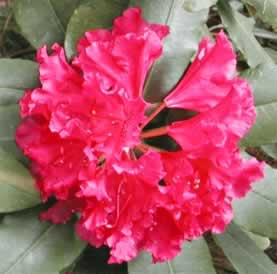 |
Low Red Frilled (PJM) |
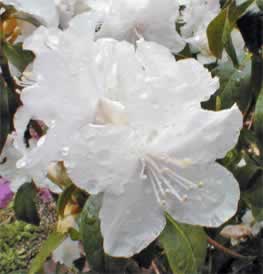 |
Molly Fordham (PJM) |
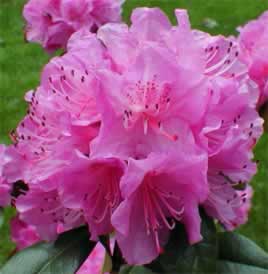 |
Olga Mezzitt (PJM) |
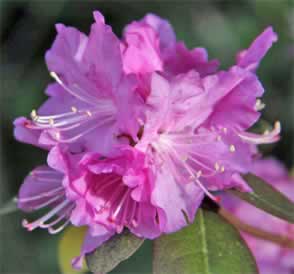 |
Regal (PJM) |
More P.J. M hybrid rhododendrons
- Low Red Frilled 4 ft (1.2 m), -25°F (-32°C), E. It has a spreading, short, compact habit and bears an abundance of showy, frilled, vivid red flowers beginning in mid-April.
- Molly Fordham – 4 ft (1.2 m) -20°F (-29°C), E. It has a compact habit and bears an abundance of showy, vivid, white flowers beginning in early May.
- Olga Mezitt – 3 ft (.9 m) -25°F (-32°C), E. It is a vigorous grower with a spreading, upright habit and bears an abundance of showy, vivid, peach-pink flowers beginning in late April.
- Regal – 5 ft (1.5 m) -30°F (-34°C), E. It is a vigorous grower with a broad, spreading habit that bears an abundance of showy, vivid, light purplish-pink flowers beginning in mid-April. [Return to List]
More Hybrid Rhododendrons for Shade
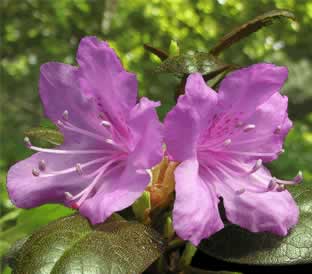 |
Victor (PJM) |
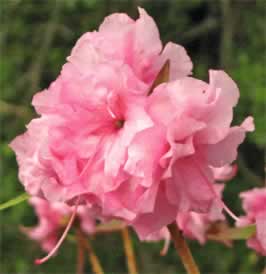 |
Weston's Pink Diamond (PJM) |
More P.J. M hybrid rhododendrons
- Victor – 4 ft (1.2 m), -25°F (-32°C), E. It is a slow grower with a compact habit and bears an abundance of showy, vivid, light purplish-pink flowers in early April.
- Weston's Pink Diamond – 5 ft (1.5 m) -10°F (-23°C), E. It is a semi-evergreen shrub with a spreading, upright habit and bears an abundance of frilled, double, vivid, pink flowers in early April. [Return to List]
More Hybrid Rhododendrons for Shade
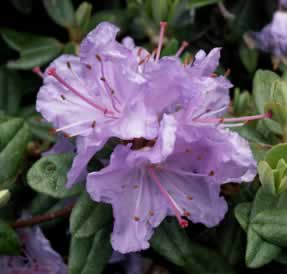 |
Ramapo |
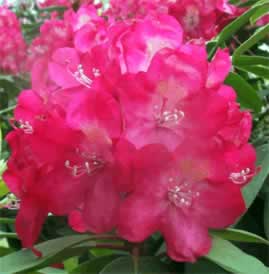 |
Red River |
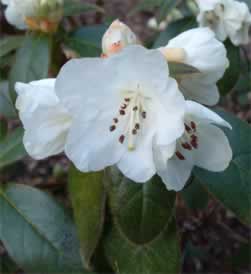 |
Snow Lady |
Ramapo – 2 ft (.6 m) -25°F (-32°C), E. It is a good dwarf rhododendron. It grows approximately 2 feet tall and 4 feet wide. Flowers are bright violet-pink. 'Ramapo' is hardy to -25°F (-32°C). Tolerates sun and shade.
Red River – 5 ft (1.5 m) -20°F (-29°C), L. It is a hybrid of a red flowered maximum. It has the late bloom and the large leaves of maximum. The flowers, larger than maximum's flowers, are bright red with a white throat and small yellow dorsal flare. A robust plant with an upright habit, it can be an open grower, but pinching will help and its habit gets better with age. Good for extending your bloom season into June. 'Red River' is hardy to -20°F (-29°C). Tolerates sun and shade.
Snow Lady – 2.5 ft (.75 m) 5°F (-15°C), E. It is a hybrid rhododendron that grows to a height of only 30 inches. It produces an abundance of snowy white flowers and has fuzzy green leaves. [Return to List]
Rhododendron & Azalea Species for Shade
Rhododendron Species for Shade
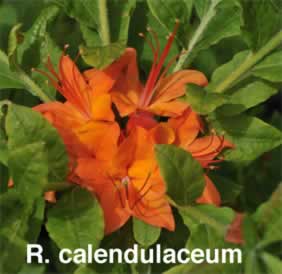 |
R. calendulaceum |
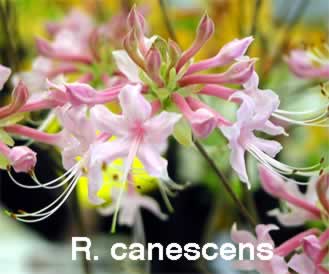 |
R. canescens |
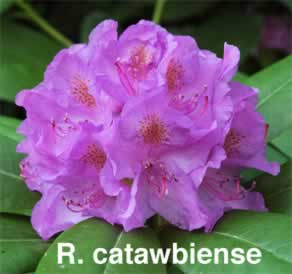 |
R. catawbiense |
Rhododendron calendulaceum – 6 ft (1.8 m), -10°F (-23°C), the flame azalea, is a native American species, growing 4 to 6 feet high. It bears clusters of 2-inch clove-scented yellow to red-orange flowers in early summer, when most other azalea species have finished blooming. The leaves are 3 inches long and drop in the fall. Does best with partial shade.
R. canescens – 5 ft (1.5 m), -5°F (-21°C), the Florida Pinxter or Piedmont Azalea. Flowers are tubular shaped, about 2 inches wide, and can vary in shading from white to pink. Very fragrant. May blooming. Prefer moist, humus-laden, acidic soil but seem to do equally well in shade or sun. Old specimens can reach heights of 12-15 feet and have multiple stems or trunks up to 5" in diameter.
Rhododendron catawbiense – 5 ft (1.5 m), -25°F (-32°C), the Catawba Rhododendron, is an evergreen shrub that grows to a height of 6 or 10 feet tall and a width of 5 to 8 feet. Though unusual, some cultivars may reach 15 or 20 feet with age. Foliage is dark green and leathery, with oval leaves, lending a course texture to the landscape. Flowers range in color from lilac to rose with green or brown markings in the throat. This plant is very hardy. It is generally dense under ideal conditions, but becomes more open in dense shade. [Return to List]
Rhododendron kiusianum – 3' 5°F (-15°C), the Kyushu azalea, is a low-growing Japanese species, only 18 inches high. Its leaves are deciduous when the plant is young but evergreen in maturity, remaining on the plant all winter, though often changing color. In its original form the Kyushu azalea is covered in mid-spring with 8- to 10-inch clusters of lilac pink flowers, but there are many named hybrids derived from this species. It prefers partial shade.
Rhododendron minus – 4 ft (1.2 m), -15°F (-26°C), the Carolina rhododendron, is a native American plant that grows wild in the Blue Ridge Mountains of North Carolina. It is 3 to 6 feet high with a naturally rounded shape and dark green leaves 3 inches long. In mid-spring it is covered with 3-inch clusters of rose-pink flowers. There is also a variety with pure white flowers and lighter green leaves, R. carolinianum 'Album'. It wants bright shade or dappled sunlight, but by no means deep shade.
Rhododendron schlippenbachii – 4 ft (1.2 m), -20°F (-29°C), the royal azalea, is a deciduous species, also of Japanese origin. It has soft green leaves that grow in whorls around the stem and turn yellow, orange and crimson in the fall. Its pink star-shaped flowers bloom in loose clusters in mid-spring and have a delicate fragrance. It needs shade from hot sun. Dappled shade or morning sun/ afternoon shade is necessary to protect the rather thin textured leaves from scorching. [Return to List]
Hybrid Deciduous Azaleas for Shade
Most deciduous azaleas do well in full sun and frequently are poor bloomers in the shade. "Maid in the Shade" deciduous azaleas are a collection of deciduous azaleas compiled by Transplant Nursery selected to do well in shadier locations. They include:
Maid In The Shade Azaleas
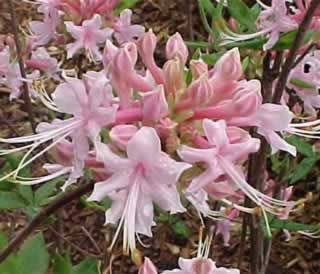 |
Camilla's Blush |
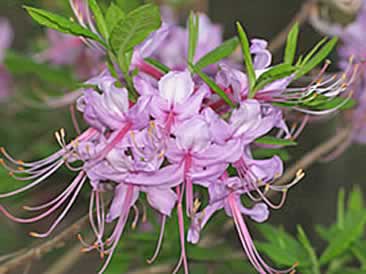 |
Lavender Girl |
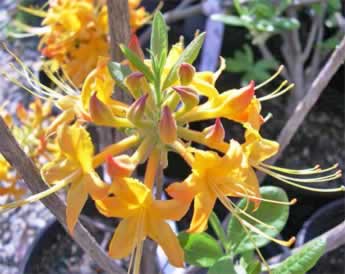 |
Lisa's Gold |
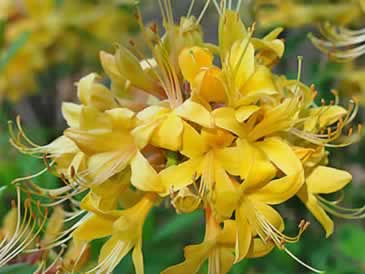 |
My Mary |
Camilla's Blush – 5 ft (1.5 m), -15°F (-26°C), . Blushing pink blooms that hummingbirds find irresistible.
Lavender Girl – 5 ft (1.5 m), -15°F (-26°C), . Pale lavender flowers
Lisa's Gold – 5 ft (1.5 m), -15°F (-26°C), . Golden-yellow flowers.
My Mary – 5 ft (1.5 m), -15°F (-26°C), . Pale yellow flowers, named as a tribute from George Beasley to his wife Mary. [return to Index]
Another Maid In The Shade Azalea
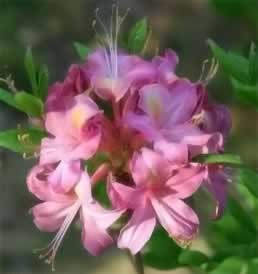 |
Rosy Cheeks |
Rosy Cheeks – 5 ft (1.5 m), -15°F (-26°C), . Dark rose flowers with golden throats. Its fragrance can rival that of a rose. [return to Index]
Hybrid Evergreen Azaleas for Shade
Most evergreen azaleas do best in partial shade, but not heavy shade. Of the various types of rhododendrons, evergreen azaleas do the poorest in heavy shade. Most will grow in heavy shade but become leggy with weak growth and will produce few if any flower buds. The group of evergreen azaleas that does best in shade is the R. obtusum series including the Kurume Azaleas. They require some shade and don't seem to be too adversely affected by moderate shade.
Kurume Azaleas Are More Tolerant of Moderate Shade
Kurume Azaleas
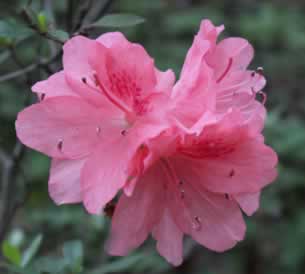 |
Blaauw's Pink |
 |
Hahn's Red |
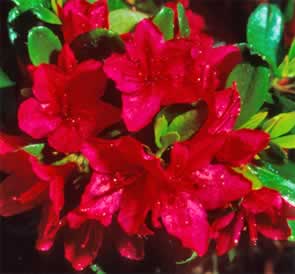 |
Hino Crimson |
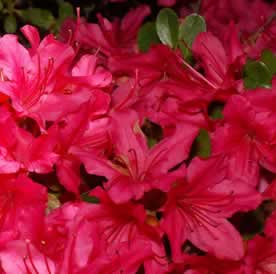 |
Hinode-giri |
Kurume azaleas were imported from Kurume, Japan, to the Arnold Arboretum in Boston in the early 1900s and soon made their way into the nursery trade. They are hardy to Zone 7, +5°F (-15°C). After five to eight years in the garden, most Kurume azaleas become dense 18- to 30-inch bushes with small glossy leaves. In spring the foliage is hidden by 1-inch flowers. For hardiness: 'Blaauw's Pink' salmon pink is hardy to Zone 6, -5°F (-26°C).
- Blaauw's Pink
– yellowish pink flower with a darker blotch, hose-in-hose.
- Hahn's Red – vivid red, faint brown spotting, hose-in-hose to semi-double.
- Hino Crimson – strong red.
- Hinode-giri – vivid purplish red. [return to Index]
More Kurume Azaleas
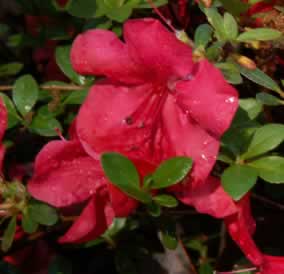 |
Mother's Day |
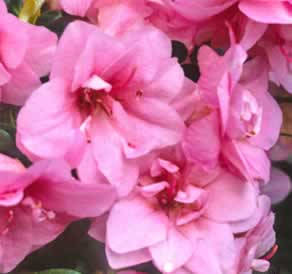 |
Rosebud |
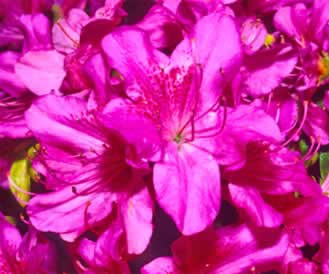 |
Sherwood Orchid |
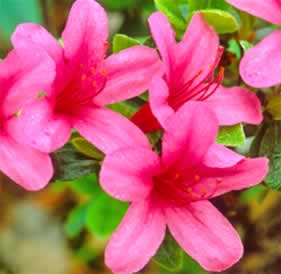 |
Sylvester |
- Mother's Day – vivid red, faint brown spotting, hose-in-hose to semi-double.
- Rosebud – pink
- Sherwood Orchid – vivid reddish purple with a darker blotch.
- Sylvester – vivid purplish red, lighter margins, very early, very hardy, good for forcing.[Return to Index]
Consider using PJMs and other Lepidotes
For locations with more shade, it is best to stick with rhododendrons that are known to tolerate more shade. If you like azaleas and have too much shade to do well with evergreen azaleas, lepidote (small leaved) rhododendrons may do well for you such as the various PJM varieties, Ramapo and Snow Lady. These lepidote rhododendrons are described above:
Sun Tolerant Rhododendrons and Azaleas
Rhododendrons and azaleas are among the most popular flowering plants for shade. But most rhododendrons will grow nicely in full sun to moderate shade. A few Rhododendron varieties such as Caroline', 'Scintillation', 'Lee's Dark Purple', Yakushimanum hybrids, 'Hong Kong' and the hardy varieties from Finland must have some shade in midday or the foliage will yellow or even burn – especially during a hot summer. Others will become infested with lace bugs if raised in full sun. These varieties need shade to prevent lace bug infestations since the natural enemies of lace bugs are much less active in sunny areas.
To be useful in full sun, rhododendron and azaleas must 1) be lace bug resistant, 2) not be prone to sun scald, and 3) not be prone to root rot. These plants are also useful in partial shade but may have problems setting flower buds and blooming if the shade is too dense. Among the most sun tolerant plants are deciduous azaleas. Below are lists of other rhododendrons and azaleas that are generally considered sun tolerant.
Hybrid Rhododendrons for Sun
Hybrid Rhododendrons for Sun
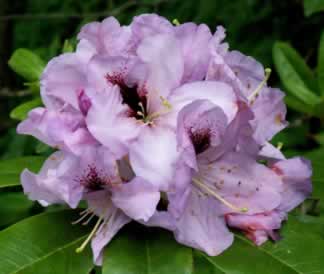 |
A. Bedford |
 |
Alena |
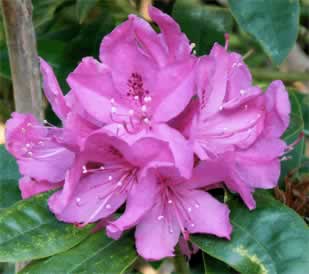 |
Anah Kruschke |
 |
Anna Rose Whitney |
A. Bedford – 5 ft (1.8 m) -5°F (-21°C), L. This large growing, vigorous rhododendron tolerates exposure to full sun. Its funnel shaped flowers with ruffled edges are pale mauve to lavender-blue with a distinctive dark blotch. This is a good selection for a background plant.
Alena – 5 ft (1.5 m), 10°F (-12°C), L. Introduced from the Czech Republic, this sun tolerant plant has fragrant white flowers with yellow spotting in the throat. There will be a slight blush on new flowers. Dark glossy leaves cover the broad, mounding plant.
Anah Kruschke – 6 ft (1.8 m), -15°F (-26°C), L. A good looking rhododendron that grows well in sunny, hot locations. Its reddish-purple flowers are held in medium sized, tight trusses. Dense and lush foliage with dark green leaves.
Anna Rose Whitney – 6 ft (1.8 m), -5°F (-21°C), LM. It is sun, heat, and shade tolerant. This plant grows quickly to form a very large, densely foliaged, well-shaped rhododendron. Deep rose-pink flowers are held in large, open trusses. [Return to List]
More Hybrid Rhododendrons for Sun
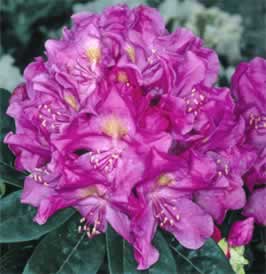 |
Aunt Martha |
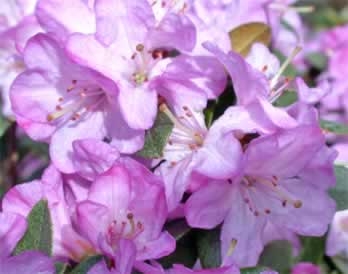 |
Barto Alpine |
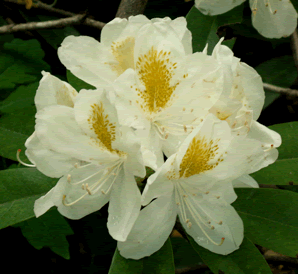 |
Belle Heller |
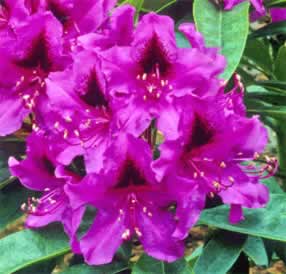 |
Black Eye |
Aunt Martha – 5 ft (1.5 m), -10°F (-23°C), L. Hardy, vigorous, densely foliated and heavy blooming plant. Plenty of leathery leaves enable the plant to grow well in full sun and moderate heat. Bright red-purple flowers are speckled with gold in the center.
Barto Alpine -3 ft (.9 m), -10°F (-23°C), E. Orchid-rose flowers open all along the stems of the densely branched plant. It has the spicy scent of freshly ground nutmeg. Its dense upright growth habit is a form well-suited for planting as a short hedge or screen reaching 5'.
Belle Heller – 5 ft (1.5 m), -10°F (-23°C), M. Here is hardiness, sun tolerance, lush foliage, and a lovely flower all in one. The large flower is pure white with a striking gold blotch, set in large, ball shaped trusses on a vigorous grower.
Black Eye – 5 ft (1.5 m), -10°F (-23°C), LM. A sister seedling of 'Red Eye', this rugged plant stands sun well and blooms young. The deep red-purple flowers have a distinct "black eye" on the upper lobe. [Return to List]
More Hybrid Rhododendrons for Sun
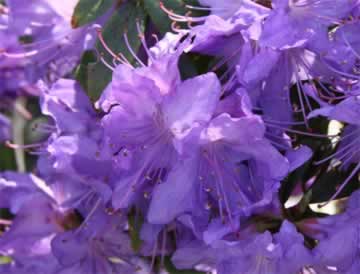 |
Blue Diamond |
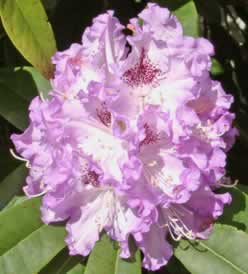 |
Blue Ensign |
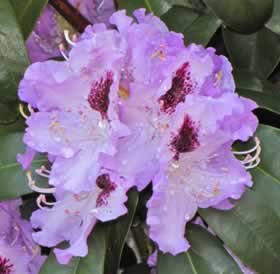 |
Blue Jay |
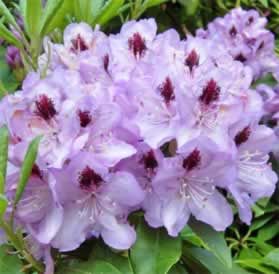 |
Blue Peter |
Blue Diamond – 3 ft (.9 m), -5°F (-21°C), E. A favorite of many gardeners, 'Blue Diamond' has small flowers all along the vertical dense, finely branched stems. A sunny location is best for this well-shaped plant often used in a border.
Blue Ensign – 4 ft (1.2 m), -15°F (-26°C), L. Very hardy, sun tolerant, lilac blue with a striking purple blotch. Its truss is similar to 'Blue Peter' and while they both become huge plants, 'Blue Ensign' is more compact.
Blue Jay – 5 ft (1.5 m) -10°F (-23°C), LM. A cold hardy, heat and sun tolerant rhododendron well worth choosing for its beauty alone! The profuse flowers are lavender-blue with pansy-violet edges and a distinctive dahlia-purple blotch. The plant is vigorous and covered with bright green foliage.
Blue Peter – 5 ft (1.5 m), -10°F (-23°C), M. Its frilled flowers are light lavender-blue with a prominent purple flare. The lush leaves are glossy green. It's vigorous, cold hardy, heat and sun resistant. [Return to List]
More Hybrid Rhododendrons for Sun
 |
Boule de Neige |
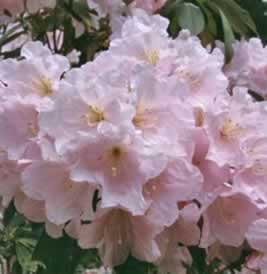 |
Cadis |
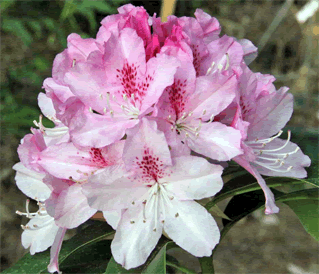 |
Cheer |
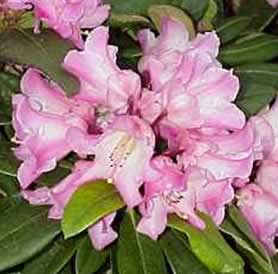 |
Cherries n Cream |
Boule de Neige – 5 ft (1.5 m) -25°F (-32°C), M. Bright green, leathery leaves on a medium sized, rounded rhododendron. It's known for its heat and sun tolerance and is extremely cold hardy. Flowers are snow white in ball shaped trusses. It even blooms well in deep shade.
Cadis – 5 ft (1.5 m) -15°F (-26°C), L. With long, narrow leaves and the fragrant, light pink trusses, this plant is a popular cold hardy hybrid from the eastern U.S. A sun tolerant selection.
Cheer – 5 ft (1.5 m), -10°F (-23°C), E. Pink trusses signal the coming of spring. Plenty of glossy, dark green leaves dress 'Cheer'. Plant grows compactly forming a dense, round mound.
Cherries 'n Cream – 3 ft (.9 m), -5°F (-21°C), E. A new plant with exceptional foliage. Sun tolerant and compact in growth habit, this plant sports large pink flowers that open from cherry-red buds. [Return to List]
More Hybrid Rhododendrons for Sun
 |
Chionoides |
 |
Christmas Cheer |
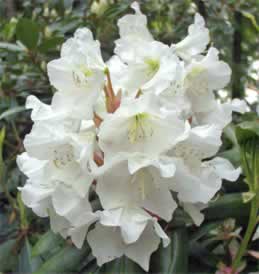 |
County of York |
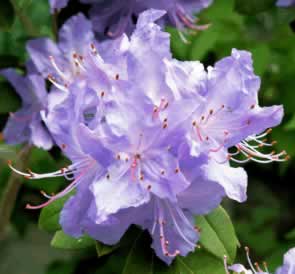 |
Crater Lake |
Chionoides – 4 ft (1.2 m), -10°F (-23°C), L. Tolerant of the sun and cold, this compact hybrid grows beautifully even when planted in locations often considered too exposed for a rhododendron. A broad, dense cushion measuring 5-6' high develops as the plant matures. White, dome trusses are bright and numerous.
Christmas Cheer – 4 ft (1.2 m), -10°F (-23°C), E. Extremely early pink trusses. Tough, medium sized leaves are dense on this well-shaped plant. It doesn't bloom at Christmas time as the name might indicate.
County of York – 6 ft (1.8 m), -15°F (-26°C), L. The real name is 'Catalode.' It is a vigorous growing plant with large, upright white trusses of good substance. Here is hardiness, good flower and large foliage, all in one hybrid. Apple-green, somewhat shiny foliage. Sun exposure and cold are well tolerated.
Crater Lake – 4-5', -5FM. Flowers are electric blue, flat and saucer shaped, with ruffled edges. They are held in groups of three, with many on a single branch. New foliage is bronze, changing to green with maturity. [Return to List]
More Hybrid Rhododendrons for Sun
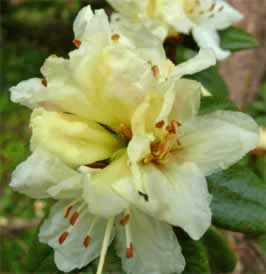 |
Cream Crest |
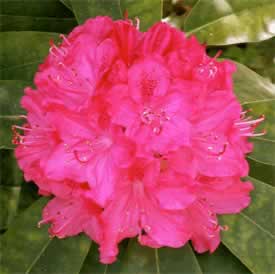 |
Cynthia |
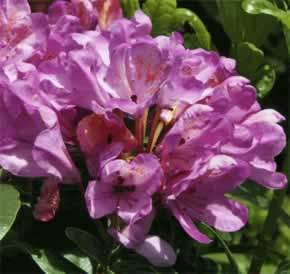 |
Daphnoides |
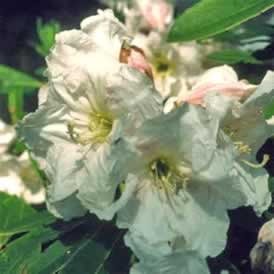 |
Disca |
Cream Crest – 3' 0°F (-18°C), E. Compact in habit, it likes the sun, has good foliage, is hardy and vigorous, and has alluring, bright, creamy yellow flowers.
Cynthia – 6 ft (1.8 m), -15°F (-26°C), M. An old favorite that is still one of the best for a strong growing, background plant. 'Cynthia' will produce a bounty of large, conical, rosy-crimson trusses. Sun and heat tolerant.
Daphnoides – 4 ft (1.2 m), -15°F (-26°C), L. Rolled, glossy leaves are tightly spaced on the stems of this dense mound. Prolific pom-pom trusses are purple.
Disca 5 ft (1.5 m), -15°F (-26°C), L. The fragrant frilled flowers open a pale pink that fades to white. 'Disca' is also a late bloomer (June). Tests as resistant to root rot and is sun and heat tolerant. [Return to List]
More Hybrid Rhododendrons for Sun
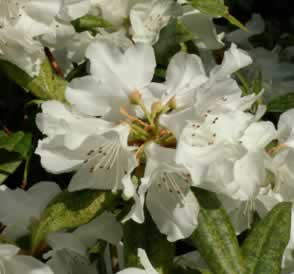 |
Dora Amateis |
 |
English Roseum |
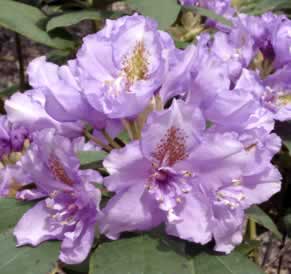 |
Fastuosum Flore Pleno |
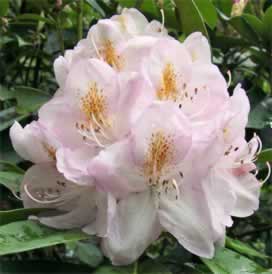 |
Gomer Waterer |
Dora Amateis – 3 ft (.9 m) -15°F (-26°C), M. Pure white flowers cling to this low growing, bushy plant. Its deep green, dense foliage is highlighted with bronze tones and is prettiest when grown in full sun. It is a spicy scented hybrid with great foliage.
English Roseum – 5 ft (1.8 m) -25°F (-32°C), LM. A soft rose pink, R. catawbiense hybrid, 6 feet or taller. A reliable 'iron-clad, English Roseum is sun, heat and cold tolerant to -25°F (-32°C). Tolerates shade well.
Fastuosum Flore Pleno – 6 ft (1.8 m), -15°F (-26°C), L. Double, lavender-blue flowers with a large golden flare on the upper dorsal lobe give extra interest to this hardy, sun tolerant hybrid. The growth habit is somewhat open but round on this fine plant. Its good foliage is dense and green.
Gomer Waterer – 6 ft (1.8 m), -15°F (-26°C), L. This old standby is one of the best whites ever hybridized. Flower buds are a delicate pink that open to blush white blossoms containing a freckling of soft green in the throat. Large deep green leaves make this an outstanding foliage plant. Very sun tolerant. [Return to List]
More Hybrid Rhododendrons for Sun
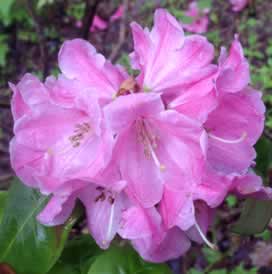 |
Hallelujah |
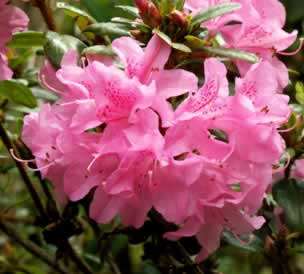 |
Hardijzer Beauty |
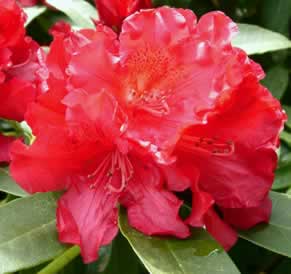 |
Jean Marie |
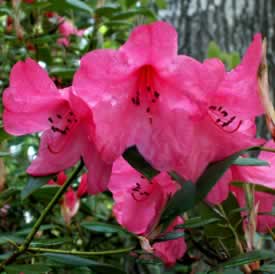 |
Jock |
Hallelujah – 4 ft (1.2 m), -15°F (-26°C), M. The leaves are a deep green, extremely heavy textured and have an attractive, downward curving form. The flowers are rose-red in a large, tight truss. It's an adaptable rhododendron.
Hardijzer Beauty – 3 ft (.9 m), -5°F (-21°C), E. A dwarf evergreen azaleodendron from Holland. This small plant is vigorous and sun tolerant. When in flower, clear pink blossoms open all along the stems. It is an excellent choice for a small bed or long, low border.
Jean Marie de Montague – 5 ft (1.5 m), -5°F (-21°C), M. Every new red introduced is judged against 'Jean Marie' (as it is often called) to see if it is better and few actually pass the grade. 'Jean Marie' has bright red flowers so showy that you can't miss them. The thick, heavy foliage stands sun and is deep emerald-green. Few plants have foliage as green. Buds young.
Jock – 3 ft (.9 m), -5°F (-21°C), E. Rosy-pink flowers are everywhere upon this rolling mound of green. The plant gives best results in full sun and is easily rooted. [Return to List]
More Hybrid Rhododendrons for Sun
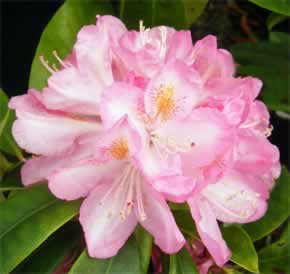 |
Lady Clementine Mitford |
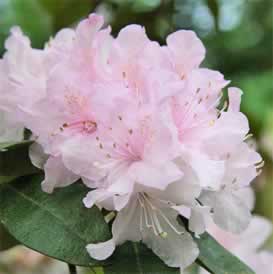 |
Manitou |
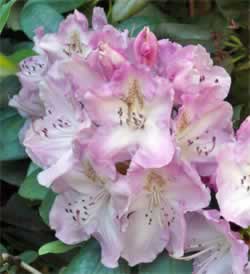 |
Mrs. C. E. Pearson |
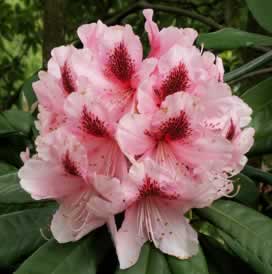 |
Mrs. G. W. Leak |
Lady Clementine Mitford – 5 ft (1.5 m), -5°F (-21°C), L. A hardy plant with distinctive gray-green leaves. The flowers are beautiful, soft peach-pink. Its foliage looks like it was sprinkled with silver. Can withstand both sun and heat. Also known as 'Lady Clementina Mitford'.
Manitou – 3 ft (.9 m), -25°F (-32°C), E. This new hybrid is similar to Windbeam, only it is more compact in growth habit. It covers itself with luscious light pink flowers from top to bottom. Its small leaves will stand sun and makes a plant to be admired in the garden.
Mrs. Charles E. Pearson – 6 ft (1.8 m), -5°F (-21°C), E. Flowers are light pink with brown spots. It was developed in 1909, received an Award of Merit in 1933 and then a First Class Certificate as late as 1955. Super vigorous with lush foliage. Sun and heat tolerant.
Mrs. G. W. Leak – 5 ft (1.8 m) 0°F (-18°C), M. Tall, vigorous plant with olive-green leaves. Clear, light pink flowers have a dark blotch in an upright compact truss. Grows in sun or shade. [Return to List]
More Hybrid Rhododendrons for Sun
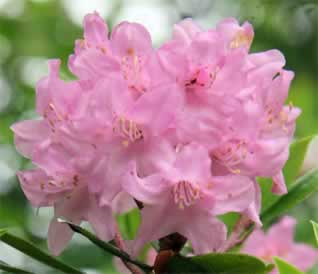 |
Myrtifolium |
 |
Nova Zembla |
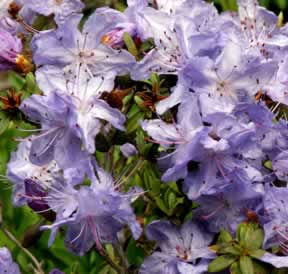 |
Oceanlake |
 |
Black Satin |
Myrtifolium – 3 ft (.9 m), -15°F (-26°C), L. For heat and sun tolerance this is extremely good. This plant has beautiful deep bronze-red foliage all winter and is a joy to view. It flowers very late in the season with small, medium pink flowers, great to extend the flowering time of rhododendrons. The plant is dense and well clothed in leathery leaves that are a rich, matte green in summer. A dependable rhododendron.
Nova Zembla – 5 ' -25°F (-32°C), M. This rhododendron has true hardiness in a red. A vigorous plant that has good foliage and will grow in more difficult areas. This hybrid exhibits some outstanding characteristics. Of course, hardiness tops the list. A nice looking contrast with other plants. Extremely showy, red flowers make a real display in the spring.. Dark red flowers in a ball-shaped cluster. Broad, bushy plant. Cold and heat tolerant and sun and shade tolerant.
Oceanlake – 30" -5°F (-21°C), M. Deep violet-blue flowers make a charming display on this small-leafed hybrid. The foliage turns interesting tones in winter. Will take sun.
PJM hybrid rhododendrons. Rhododendrons in the 'P.J.M.' group are smaller, growing to a height of 3 to 5 feet tall. Form is rounded and the foliage is leathery and dark green until fall when it turns almost purplish. One of the reasons rhododendrons in the 'P.J.M.' group are such heavy bloomers is that the plants do not set seed. They are very hardy, among the hardiest and most shade tolerant rhododendrons. They include the following:
- Black Satin, – 3 ft (.9 m), -20°F (-29°C), E. It has a semi-erect habit and bears an abundance of showy, vivid, dark rose-pink flowers in mid-April. Fall and winter foliage is glossy and very dark purplish-black.
[Return to List]
More Hybrid Rhododendrons for Sun
 |
Desmit |
 |
Elite |
 |
Henry's Red |
 |
Low Red Frilled |
More PJM
- Desmit, – 1 ft (.3 m), -20°F (-29°C), E. It has a dense, mounding habit and bears an abundance of vivid, showy, pink flowers in early April. This cultivar has shown to be moderately resistant to sun scalding.
- Elite, – 4 ft (1.2 m), -25°F (-32°C), E. It is a vigorous, tall grower and bears an abundance of vivid, showy, rich pink flowers in mid-April.
- Henry's Red, – 4 ft (1.2 m), -25°F (-32°C), E. It has a broad, upright habit and bears an abundance of showy, vivid, deep red flowers beginning in mid-April.
- Low Red Frilled, – 4 ft (1.2 m), -25°F (-32°C), E. It has a spreading, short, compact habit and bears an abundance of showy, frilled, vivid red flowers beginning in mid-April.
[Return to List]
More Hybrid Rhododendrons for Sun
 |
Molly Fordham |
 |
Olga Mezzitt |
 |
Regal |
 |
Victor |
More PJM
- Molly Fordham, – 4 ft (1.2 m), -20°F (-29°C), E. It has a compact habit and bears an abundance of showy, vivid, white flowers beginning in early May.
- Olga Mezzitt, – 4 ft (1.2 m), -25°F (-32°C), E. It is covered in winter with mahogany colored, small leaves that are bright green in summer. In spring it is transformed by numerous trusses of clear pink on every limb of the plant. It's hardy and sun tolerant making it especially valued if you don't have much shade in your garden.
- Regal, – 5 ft (1.5 m), -30°F (-34°C), E. It is a vigorous grower with a broad, spreading habit that bears an abundance of showy, vivid, light purplish-pink flowers beginning in mid-April.
- Victor, – 4 ft (1.2 m), -25°F (-32°C), E. It is a slow grower with a compact habit and bears an abundance of showy, vivid, light purplish-pink flowers in early April. [Return to List]
More Hybrid Rhododendrons for Sun
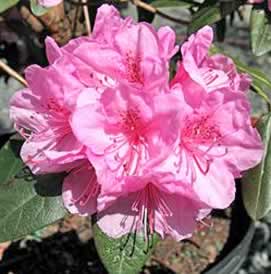 |
Weston's Aglo |
 |
Weston's Pink Diamond |
 |
Ramapo |
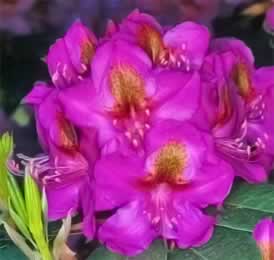 |
Red Eye |
More PJM
- Weston's Aglo, – 3 ft (.9 m), -25°F (-32°C), E. It has the same parentage as 'Olga Mezzitt', this flower exhibits many of the same super qualities, such as sun tolerance and early flowering. This upright plant has flowers of light pink with a reddish eye.
- Weston's Pink Diamond, – 5 ft (1.5 m), -15°F (-26°C), E. It is a semi-evergreen shrub with a spreading, upright habit and bears an abundance of frilled, double, vivid, pink flowers in early April.
Ramapo – 2 ft (.6 m), -20°F (-29°C), E. Plentiful pale violet flowers are amid a bushy blue-green mat of leaves. This hardy dwarf can be grown in sun or partial shade, although in full sun it will maintain a more compact form. It is well suited for use in a low border or rock garden.
Red Eye – 6 ft (1.8 m), -10°F (-23°C), L. This plant stands sun, buds young, branches readily and does not mind heavy cutting for propagation! It's a plant you can depend on year after year. The flowers are deep red-purple with an interesting eye. When the flower first opens, the eye is green gold and little by little it becomes red. It is an interesting contrast with the purple! 'Red Eye' is a misnomer because the "eye" isn't always red.[Return to List]
More Hybrid Rhododendrons for Sun
 |
Rose Elf |
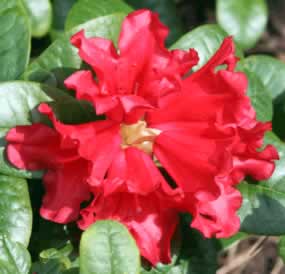 |
Scarlet Wonder |
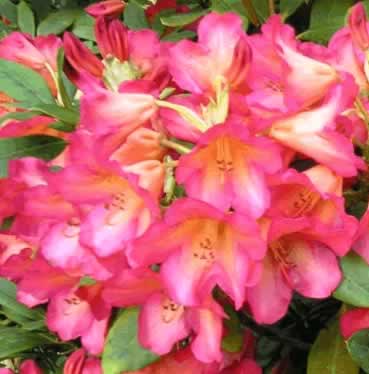 |
Sonata |
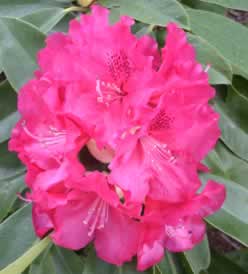 |
Trilby |
Rose Elf – 18" 5°F (-15°C), E. Often there are six or eight flower buds per stem that open to a delightful pastel orchid pink. Jade green leaves are numerous along this bushy multiple stemmed plant. In full sun exposure the leaves take on a bronze cast. 'Rose Elf' forms a bushy low border. It is well suited also to rock gardening and bonsai culture.
Scarlet Wonder – 2 ft (.6 m), -15°F (-26°C), M. 'Scarlet Wonder' is a low, exceptionally compact plant with dense glossy green leaves that have an interesting texture. The plant will stand more sun and exposure than most. This is a great foliage that plant, that, when it blooms, turns into a mass of brilliant scarlet red.
Sonata – 3' 0°F (-18°C), L. 'Sonata' has tubular shaped, orange-red flowers edged in red. The mass of slender, dark green leaves do well in a sunny spot.
Trilby – 5 ft (1.5 m), -15°F (-26°C), L. Beautiful flowers of deep crimson with black marking. Matte green leaves are set off against red stems to beautify the plant even when not in flower. Sun tolerant. [Return to List]
More Hybrid Rhododendrons for Sun
 |
Wissahickon |
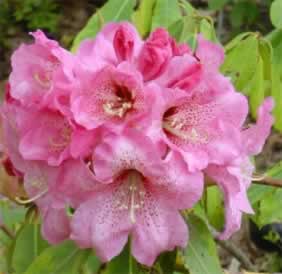 |
Wyandanch Pink |
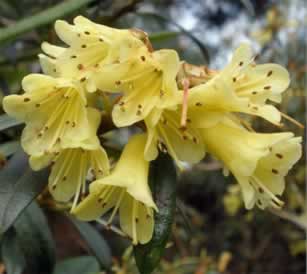 |
Yellow Hammer |
Wissahickon – (parentage unknown) 5 ft (1.5 m), -15°F (-26°C), M. A good choice if you are looking for a vigorous growing variety that is sun tolerant. The bright rose flowers, with a deeper throat, have brownish spotting. A plant of good reputation in the East.
Wyandanch Pin – 5 ft (1.5 m), -15°F (-26°C), M. This is the rhododendron for that sunny spot in the yard as it does best in the sun. Excellent foliage highlight the vivid pink flowers spotted darker on the upper lobe.
Yellow Hammer – 4' 5°F (-15°C), E. Very deep yellow flowers are held on an upright growing plant. Can be trimmed easily and makes a good hedge. One of the few yellow rhododendrons that will do well in sunny locations. [Return to List]
For a list of hybrid rhododendrons good for sun and heat visit Hybrid Rhododendrons for Sun and Heat.
Rhododendron Species for Sun
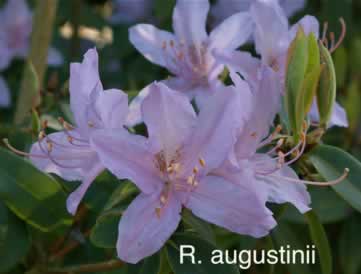 |
 |
 |
 |
Rhododendron augustinii ssp. augustinii – 6 ft (1.8 m), 0°F (-18°C). The smooth leaves, small, long, and dark green, have densely scaled undersides. It's a strong grower and flowers in abundance, a radiant blue color not to be forgotten.
Rhododendron augustinii ssp. chasmanthum – 6 ft (1.8 m), 0°F (-18°C). Flowers are widely funnel shaped giving then tighter trusses and are typically later than R. augustinii. Leaves are often wider and can be partly deciduous. A good, strong grower with excellent sun tolerance.
R. calendulaceum – 6 ft (1.8 m), -10°F (-23°C). The flame azalea, is one of the most brightly colored of native North American shrubs, bearing large clusters of 2-inch flowers in early summer. Plants usually grow 4 to 9 feet tall in Zones 5-8, hardy to -10°F (-23°C), and occasionally reach 15 feet. It bears clusters of 2-inch clove-scented bright scarlet, orange or yellow flowers in late spring or early summer flowers that are long lasting, even in full sun. The leaves are 3 inches long and drop in the fall.
Rhododendron hippophaeoides var. hippophaeoides -2', -20°F (-29°C). The hardiest plant of the species, this variety withstands frost even when in flower. It is also tolerant of sun and swampy conditions. The flowers are lavender-blue. [Return to List]
Rhododendron impeditum – 1 ft (.3 m), -15°F (-26°C), . One of the best dwarf rhododendrons, this species has a tight compact habit with attractive silver-gray foliage. Bright blue-purple flowers make a nice contrast. Planted about 15" apart, a number of plants will grow together to form an impenetrable ground cover, handsome at all seasons and especially effective when such an expanse becomes a blanket of blue flowers."
Rhododendron lutescens – 6 ft (1.8 m), 5°F (-15°C). Sunny yellow flowers bloom amidst bronzy red foliage. Open and upright, the new growth is bright red, and creates quite a display in itself. The medium sized leaves, that range in color from dull dark green to a lovely bronzy red, are oblong or lance shaped. Very sun tolerant.
Rhododendron racemosum – 2 ft (.6 m), -10°F (-23°C). Does well in sunny locations. It grows many erect red stems lined with glossy round leaves. Pink flower buds occur along upper portions of the stem and in multiples at stem tips. Fairly early in the flowering season, R. racemosum will appear as a bundle of clear pink plumes.
Rhododendron trichostomum – 30", 0°F (-18°C). Numerous small, tubular flowers will last for a month. The succulent flowers are a clear light pink, resembling the flowers of daphne more than rhododendron. A sunny location has proven to be best. [Return to List]
Azaleas for Sun
 |
Aut. Amethyst |
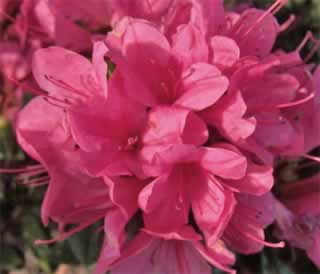 |
Aut. Cheer |
 |
Aut. Rouge |
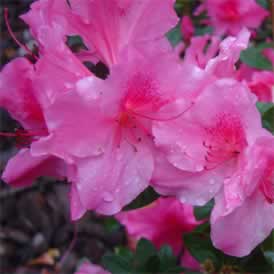 |
Aut. Royalty |
Encore® azaleas need full sun in order to rebloom properly. All varieties need full sun. Here are some:
- Autumn Amethyst, -10°F (-23°C), Low/Med. This lavender is one of the Encore® reblooming azaleas.
- Autumn Cheer, -10°F (-23°C), Low. This pink is one of the Encore® reblooming azaleas.
- Autumn Rouge, -5°F (-21°C), Low/Med. This bright pink is one of the Encore® reblooming azaleas.
- Autumn Royalty, -10°F (-23°C), Med. This purple is one of the Encore® reblooming azaleas. [Return to List]
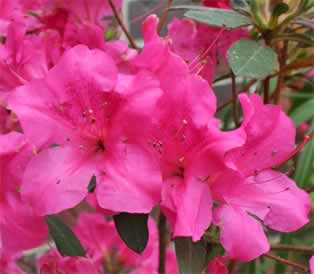 |
Aututumn Sangria |
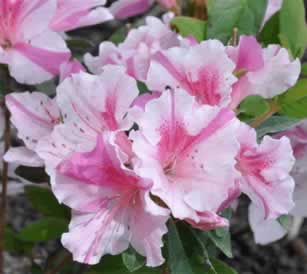 |
Autumn Twist |
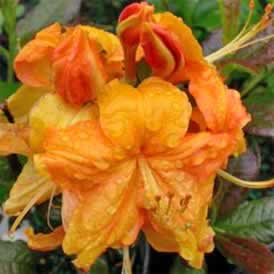 |
Klondyke |
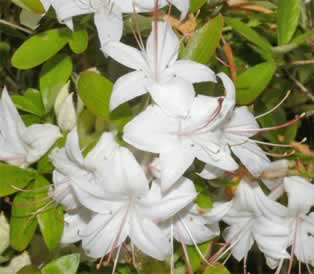 |
Weston's Innocence |
- Autumn Sangria -10°F (-23°C), Med. This dark pink is one of the Encore® reblooming azaleas.
- Autumn Twist, -10°F (-23°C), Med. This white with purple markings is one of the Encore® reblooming azaleas.
Deciduous Azaleas – Most deciduous azaleas are hardy to -25°F (-32°C), grow well in the sun and really can be grown practically anywhere. They frequently are poor bloomers in the shade.
- Klondyke – (Exbury) 8', -15°F (-26°C), . Buds are a vivid orange and yellow and burst open to brilliant, golden-yellow flowers. The color is unlike any other. And the new foliage is a scintillating bronze. Fragrant.
- Weston's Innocence – (Weston) 3 ft (.9 m), -25°F (-32°C). A spectacular hybrid that blooms in mid to late June. The strongly fragrant white flowers are abundant. A vigorously growing wide plant with upright branches, it is compact and becomes mound shaped with age. The glossy leaves are resistant to mildew and have a deep red fall color. Takes full sun. [Return to List]
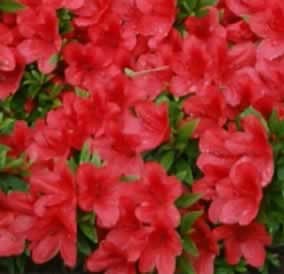 |
Flame Creeper |
 |
Hino Crimson |
 |
Hinode-giri |
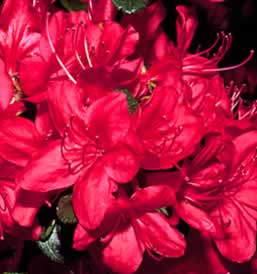 |
Stewartsonian |
Flame Creeper – Late -10°F (-23°C), Dwarf. Noted for its tolerance of full sun, this reliable azalea displays a profusion of scarlet-orange flowers. It makes a good ground cover with its small leaves and creeping habit.
Hino Crimson – Early -10°F (-23°C), Low/Med. Bright crimson flowers unfold in April, and holding their color well. This attribute, coupled with sun tolerance and red winter foliage, makes 'Hino Crimson' an excellent all around choice. Planted in the open, it grows to a dense 2½' mound, although it adapts well for use as hedging.
Hinode-giri – Early -5°F (-21°C), Medium. One of the more sun-tolerant hybrids, this azalea produces multitudes of rose-crimson flowers early to mid-season. Small, glossy leaves turn bright red in winter on this dense plant.
Stewartstonian – Early -20°F (-29°C), Medium. A sun tolerant hybrid, 'Stewartstonian' displays lush red 2" blooms that, in the light, appear blood orange. Winter foliage deepens to wine red, making it an excellent winter foliage plant. [Return to List]
Heat Tolerant Rhododendrons & Azaleas
In tropical climates, the best rhododendrons are the Vireya, a type which is native to the tropical regions of Southeast Asia. Their culture is completely different from other rhododendrons and azaleas. They must be grown like orchids. This section will deal with non-tropical rhododendrons and azaleas that can withstand warmer climates such as the southeastern US including Eastern Oklahoma.
Heat Tolerant Rhododendrons
The quest for heat tolerant rhododendrons has focused on the very heat tolerant Rhododendron hyperythrum. Retired veterinarian and longtime plant breeder Dr. John Thornton of Franklinton, La. has been hybridizing for heat tolerance extensively using the species hyperythrum. His hybrids include: R. 'Hypermax' (R. hyperythrum x R. maximum), R. 'Charles Loomis' ('English Roseum' x R. hyperythrum), R. 'Peppermint Twist' (R. hyperythrum x 'Princess Elizebeth'), R. 'Michelle Smith' (R. 'Scintillation' x R. hyperythrum) and the Southgate Series.
R. hyperythrum and its hybrids
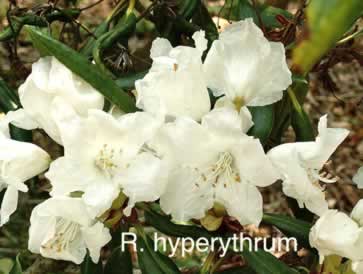 |
R hyperythrum |
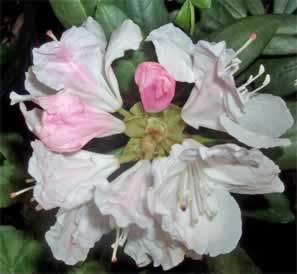 |
Charles Loomis |
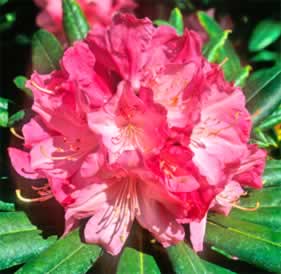 |
Peppermint Twist |
R. hyperythrum – 3', -10°F (-23°C). This is a compact shrub with white flowers with reddish flecks. It has good cold and heat tolerance. It will grow in the southeastern United States. It is native only to N Taiwan.
Charles Loomis – 4 ft (1.2 m), -15°F (-26°C), . Flowers are rounded trusses emerging first as blush pink and quickly fading to white, much like yak hybrids. The foliage is narrow and recurved. The plant retains its leaves for 3 to 4 years. Buds heavily. This one will take rough treatment.
Peppermint Twist – 4 ft (1.2 m), -15°F (-26°C), . It has red buds, opening to rose pink flowers, with red flecks in the throat and a white circle in the throat that slowly grows larger each day. Just as attractive as the flowers is the glossy dark green foliage, that is held for three years on a vigorous, but compact, plant. [Return to List]
The Southgate™ series of R. hyperythrum hybrids
Dr. John Thornton of Franklinton, LA, has released a collection of his hybrids of R. hyperythrum with popular hardy East Coast hybrid rhododendrons. The goal is to be able to have rhododendron hybrids that will grow in the Southeastern US and still be hardy in the Mid-Atlantic states. Dr. Thornton started this breeding effort in the early 1970s. These plants were trialed in the New Orleans area for several years. Dr. Thornton released his plants as trademarked plants through Southern Living Plants and wholesale production has begun. Besides being touted as heat-tolerant, they are being labeled as being hardy to -10F and for Zones 6 through 9
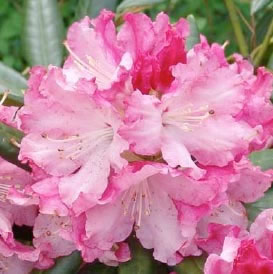 |
Southgate™ Brandi |
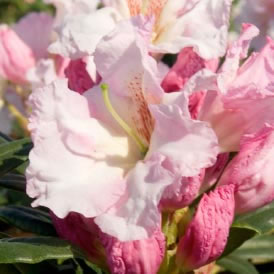 |
Southgate™ Breezy |
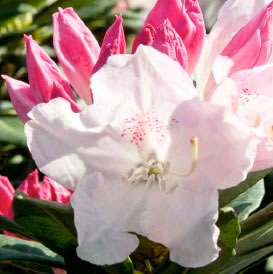 |
Southgate™ Divine |
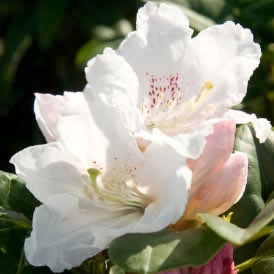 |
Southgate™ Grace |
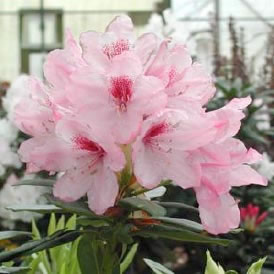 |
Southgate™ Radiance |
Southgate™ Brandi, 'Brandy Michelle Raley': 'Scintillation' x white form of R. hyperythrum - It has deep pink buds that open to pink, ruffled blooms with a dense habit and dark green, recurved, glossy leaves. Grows to 3' tall by 4' wide in 10 years.
Southgate™ Breezy, 'Breezy': 'Janet Blair' x pink form R. hyperythrum R. hyperythrum - It has medium pink buds that open to white with a prominent maroon blotch and a medium-dense habit with medium-green leaves. Grows to 4' tall by 5' wide in 10 years.
Southgate™ Divine, 'Lisenne Rockefeller': 'Catalode' x R. hyperythrum - It has light-pink buds opening to white with purple specks and has a medium-dense habit with medium-green leaves. Grows to 4' tall by 5' wide in 10 years.
Southgate™ Grace, 'Elizabeth Arden': 'English Roseum' x white form of R. hyperythrum - It has deep pink buds that open white, a dense habit and recurved leaves. Grows to 4' tall by 5' wide in 10 years.
Southgate™ Radiance, 'Tyler Morris': 'Royal Purple' x R. hyperythrum - It has deep lavender buds that open to light purple and has a medium-dense habit. Grows to 4' tall by 6' wide in 10 years.
Other varieties known for their Heat Tolerance include some Tolerant of Sun and Heat:
† indicates Rhododendrons Tolerant of Sun and Heat
†† indicates rhododendrons that are not only heat & sun tolerant, but are cold tolerant:
††† indicates rhododendrons that are not only heat, sun, & cold tolerant, but are also shade tolerant:
Ironclads for the 21st Century
19 rhododendrons that are not only heat & sun tolerant, but are cold tolerant:
|
|
And the PJM varieties:
|
|
14 rhododendrons that are not only heat, sun, & cold tolerant, but are also shade tolerant:
And the PJM varieties:
|
|
|
Hybrid Rhododendrons for Heat
 |
A. Bedford
|
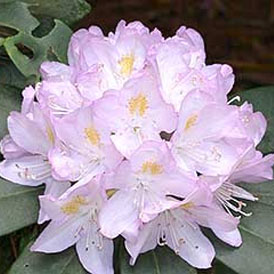 |
|
Album Elegans
|
 |
|
Anah Kruschke
|
 |
|
Anna Rose Whitney
|
A. Bedford – 5 ft (1.8 m) -5°F (-21°C), ’M. This large growing, vigorous rhododendron tolerates exposure to full sun and is heat tolerant. Its funnel shaped flowers with ruffled edges are pale mauve to lavender-blue with a distinctive dark blotch. This is a good selection for a background plant.
Album Elegans – 5 ft (1.8 m) -25°F (-32°C), LM. Opens a bluish white with a greenish-yellow blotch and fades to white. Tolerates heat well.
Anah Kruschke – 5 ft (1.5 m) -15°F (-26°C), LM. A good looking rhododendron that grows well in sunny, hot locations. Its reddish-purple flowers are held in medium sized, tight trusses. Dense and lush foliage with glossy dark green leaves.
Anna Rose Whitney – 5 ft (1.8 m) -5°F (-21°C), LM. It is sun, heat, and shade tolerant. This plant grows quickly to form a very large, densely foliaged, well-shaped rhododendron. Deep rose-pink flowers are held in large, open trusses. [Return to List]
More Hybrid Rhododendrons for Heat
 |
|
Aunt Martha
|
 |
Blue Jay |
 |
Blue Peter |
 |
Boule de Neige |
Aunt Martha – 5 ft (1.5 m) -10°F (-23°C), L. Hardy, vigorous, densely foliated and heavy blooming plant. Plenty of leathery leaves enable the plant to grow well in full sun and moderate heat and is cold hardy. Bright red-purple flowers are speckled with gold in the center.
Blue Jay – 5 ft (1.5 m) -10°F (-23°C), LM. A cold hardy, heat and sun tolerant rhododendron well worth choosing for its beauty alone! The profuse flowers are lavender-blue with pansy-violet edges and a distinctive dahlia-purple blotch. The plant is vigorous and covered with bright green foliage.
Blue Peter – 5 ft (1.5 m) -10°F (-23°C), M. Its frilled flowers are light lavender-blue with a prominent purple flare. The lush leaves are glossy green. It's vigorous, cold hardy, heat and sun resistant.
Boule de Neige – 5 ft (1.5 m) -25°F (-32°C), M. Bright green, leathery leaves on a medium sized, rounded rhododendron. It's known for its heat and sun tolerance and is extremely cold hardy. Flowers are snow white in ball shaped trusses. It even blooms well in deep shade. [Return to List]
More Hybrid Rhododendrons for Heat
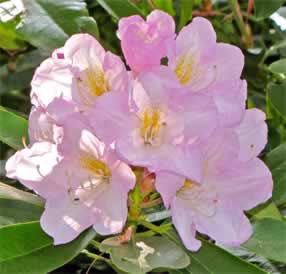 |
Caroline |
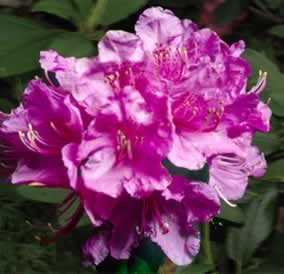 |
Chapmanii Wonder |
 |
Cynthia |
 |
Disca |
Caroline – 5 ft (1.8 m) -15°F (-26°C), LM. An exceptionally good grower the is remarkably resistant to fungal root diseases. The large flowers are light orchid pink, moderately fragrant, in loose trusses on a plant with fairly narrow, light green leaves. It is heat tolerant but too much sun may discolor the leaves.
Chapmanii Wonder – 4.5 ft (1.35 m), -15°F (-26°C), E-EM. This rhododendron from Japan was hybridized specifically to stand the temperatures of the highland areas, where it is very cold and the ground freezes in winter. It also withstands the summer heat of its moist, hot, oriental home. It is very vigorous growing, rapidly becoming a good sized plant. The foliage and the plant are similar to 'PJM', as its parentage is related; however, the chapmanii in this plant provides more heat tolerance than the carolinianum in 'PJM'. The flowers are bright lavender-pink. Needs pruning to keep it compact. Requires some shade.
Cynthia – 5 ft (1.8 m) -15°F (-26°C), M. An old favorite that is still one of the best for a strong growing, background plant. 'Cynthia' will produce a bounty of large, conical, rosy-crimson trusses. For heat and sun tolerance this is extremely good and fairly good for cold hardiness.
Disca 5 ft (1.5 m), -15°F (-26°C), L. The fragrant frilled flowers open a pale pink that fades to white. 'Disca' is also a late bloomer (June). Tests as resistant to root rot and is sun and heat tolerant. [Return to List]
More Hybrid Rhododendrons for Heat
 |
English Roseum |
 |
Evening Glow |
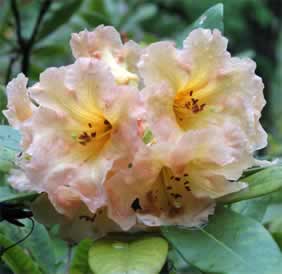 |
Goldsworth Orange |
 |
Janet Blair |
English Roseum – 6 ft (1.8 m), -25°F (-32°C), M. It is a soft rose pink, R. catawbiense hybrid, 6 feet or taller. A reliable 'iron-clad, English Roseum is also sun and cold tolerant to -25F.
Evening Glow – 5 ft (1.5 m), -5°F (-21°C), L. A deep yellow that blooms in June. Shamrock-green, narrow leaves are bright year round. The plant has a compact growth habit and is one of the best for heat, but does require some shade.
Goldsworth Orange – 5 ft (1.5 m), -5°F (-21°C), L. June blooming tropical orange flowers are bright in the early summer sun. Each truss holds many widely flared, funnel shaped flowers. Felt green leaves are held by red petioles on this shapely, heat tolerant hybrid. Requires some shade.
Janet Blair – 5 ft (1.5 m) -20°F (-29°C), M. 'Janet Blair' has large, fragrant, frilled lavender pink flowers fading to a pale center and topped off by a blotch of yellow rays on the upper lobes. The plant, with its glossy green foliage and mounding habit, is not only cold hardy but also heat tolerant. Blooms third week of May, and is better in moderate shade than most other varieties. [Return to List]
More Hybrid Rhododendrons for Heat
 |
Lady Clementine Mitford |
 |
Mrs. Charles E. Pearson |
 |
Myrtifolium |
 |
Nova Zembla |
Lady Clementine Mitford – 5 ft (1.5 m) -5°F (-21°C), L. A hardy plant with distinctive gray-green leaves. The flowers are beautiful, soft peach-pink. Its foliage looks like it was sprinkled with silver. Can withstand both sun and heat. Also known as 'Lady Clementina Mitford'.
Mrs. Charles E. Pearson – 6 ft (1.8 m), -5°F (-21°C), M. Flowers are light pink with brown spots. It was developed in 1909, received an Award of Merit in 1933 and then a First Class Certificate as late as 1955. Most hybrids win something only when they are new, never to be heard from again! Super vigorous with lush foliage. Sun and heat tolerant.
Myrtifolium – 3 ft (.9 m), -15°F (-26°C), L. For heat and sun tolerance this is extremely good and fairly good for cold hardiness. This plant has beautiful deep bronze-red foliage all winter and is a joy to view. It flowers very late in the season with small, medium pink flowers, great to extend the flowering time of rhododendrons. The plant is dense and well clothed in leathery leaves that are a rich, matte green in summer. A dependable rhododendron.
Nova Zembla – 5 ' -25°F (-32°C), M. This rhododendron has true hardiness in a red. A vigorous plant that has good foliage and will grow in more difficult areas. This hybrid exhibits some outstanding characteristics. Of course, hardiness tops the list. A nice looking contrast with other plants. Extremely showy, red flowers make a real display in the spring.. Dark red flowers in a ball-shaped cluster. Broad, bushy plant. Cold and heat tolerant and sun and shade tolerant. [Return to List]
More Hybrid Rhododendrons for Heat
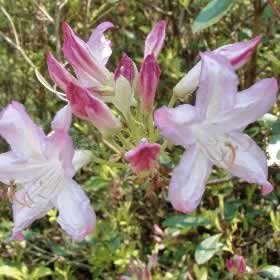 |
Odoratum |
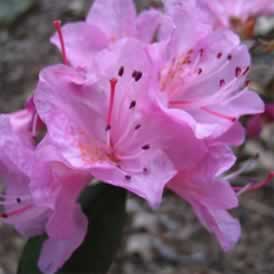 |
Pink Magic |
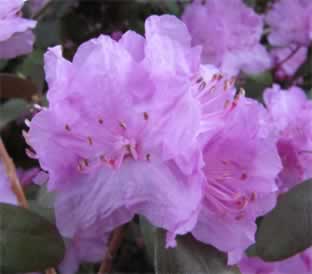 |
PJM |
 |
Black Satin |
Odoratum – 4 ft (1.2 m), -15°F (-26°C), L. This old azaleodendron should not be overlooked in today's gardens. It is delightfully fragrant. Orchid-lilac flowers are nicely accented by the moss green foliage. Heat tolerant. Requires some shade.
Pink Magic – 4-5 ft (1.5 m), -10°F (-23°C), EM. A lepidote with glossy apple green foliage and large pink, somewhat bell-shaped early flowers. This is almost the same cross as the popular white hybrid 'Dora Amateis', but this is pink rather than white and is a heat tolerant, dependable grower. It can burn in northern, colder winters, but it always recovers.
PJM – 4 ft (1.2 m) -25°F (-32°C), E. This hybrid is cold hardy as well as tolerant of heat and sun. Its small, rounded leaves are green during the summer and mahogany colored in winter. 'PJM's' early bright lavender-pink flowers are beautiful against its dark colored winter foliage. PJM is cold hardy and tolerant of heat and sun. It has one drawback. Its early bright lavender-pink blooms are so early that sometimes the blooms are killed by an early frost. The glossy green foliage of summer becomes mahogany-colored in winter. It is an excellent landscape plant, will grow under most conditions, and the flowers are long lasting. The flowers are somewhat smaller than most other rhododendrons. There are several newer varieties of PJM. One of the reasons rhododendrons in the 'P.J.M.' group are such heavy bloomers is that the plants do not set seed. They are very hardy, among the hardiest and most shade tolerant rhododendrons. They include the following:
- Black Satin, – 3 ft (.9 m), -20°F (-29°C), E. It has a semi-erect habit and bears an abundance of showy, vivid, dark rose-pink flowers in mid-April. Fall and winter foliage is glossy and very dark purplish-black.
[Return to List]
More Hybrid Rhododendrons for Heat
 |
Desmit |
 |
Elite |
 |
Henry's Red |
 |
Low Red Frilled |
More PJM
- Desmit, – 1 ft (.3 m), -20°F (-29°C), E. It has a dense, mounding habit and bears an abundance of vivid, showy, pink flowers in early April. This cultivar has shown to be moderately resistant to sun scalding.
- Elite, – 4 ft (1.2 m), -25°F (-32°C), E. It is a vigorous, tall grower and bears an abundance of vivid, showy, rich pink flowers in mid-April.
- Henry's Red, – 4 ft (1.2 m), -25°F (-32°C), E. It has a broad, upright habit and bears an abundance of showy, vivid, deep red flowers beginning in mid-April.
- Low Red Frilled, – 4 ft (1.2 m), -25°F (-32°C), E. It has a spreading, short, compact habit and bears an abundance of showy, frilled, vivid red flowers beginning in mid-April.
[Return to List]
More Hybrid Rhododendrons for Heat
 |
Molly Fordham |
 |
Olga Mezzitt |
 |
Regal |
 |
Victor |
More PJM
- Molly Fordham, – 4 ft (1.2 m), -20°F (-29°C), E. It has a compact habit and bears an abundance of showy, vivid, white flowers beginning in early May.
- Olga Mezzitt, – 4 ft (1.2 m), -25°F (-32°C), E. It is covered in winter with mahogany colored, small leaves that are bright green in summer. In spring it is transformed by numerous trusses of clear pink on every limb of the plant. It's hardy and sun tolerant making it especially valued if you don't have much shade in your garden.
- Regal, – 5 ft (1.5 m), -30°F (-34°C), E. It is a vigorous grower with a broad, spreading habit that bears an abundance of showy, vivid, light purplish-pink flowers beginning in mid-April.
- Victor, – 4 ft (1.2 m), -25°F (-32°C), E. It is a slow grower with a compact habit and bears an abundance of showy, vivid, light purplish-pink flowers in early April. [Return to List]
More Hybrid Rhododendrons for Heat
 |
Weston's Aglo |
 |
Weston's Pink Diamond |
More PJM
- Weston's Aglo, – 3 ft (.9 m), -25°F (-32°C), E. It has the same parentage as 'Olga Mezzitt', this flower exhibits many of the same super qualities, such as sun tolerance and early flowering. This upright plant has flowers of light pink with a reddish eye.
- Weston's Pink Diamond, – 5 ft (1.5 m), -15°F (-26°C), E. It is a semi-evergreen shrub with a spreading, upright habit and bears an abundance of frilled, double, vivid, pink flowers in early April. [Return to List]
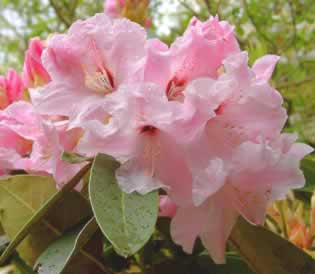 |
Platinum Pearl |
 |
Red Eye |
 |
Scintillation |
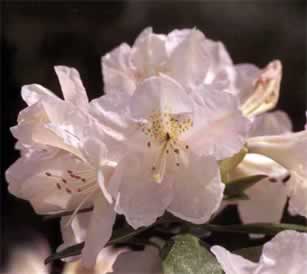 |
Southland |
Platinum Pear – 6 ft (1.8 m), -10°F (-23°C), M. Tests performed in California and Georgia, showed good tolerance to heat as well as cold and adverse cultivation. This strong grower forms huge flower buds early in the fall. Each pearl pink flower is made showier by a dark rose blotch at the base. The foliage is large, leek green and on sturdy stems that are well able to hold up the huge trusses. Best grown in light shade where the foliage develops to near perfection.
Red Eye – 5 ft (1.5 m) -10°F (-23°C), L. This plant stands sun, buds young, branches readily and does not mind heavy cutting for propagation! It's a plant you can depend on year after year. The flowers are deep red-purple with an interesting eye. When the flower first opens, the eye is green gold and little by little it becomes red. It is an interesting contrast with the purple! 'Red Eye' is a misnomer because the "eye" isn't always red.
Scintillation – 4 ft (1.2 m) -15°F (-26°C), M. Very popular with pink flowers of good substance with a brown & bronzy flair. The leaves are an attractive dark glossy green. It is reasonably heat tolerant but needs some protection from the sun in hot areas to prevent leaf burn.
Southland – 2 ft (.6 m), -10°F (-23°C), M. A truly fine lepidote, 'Southland' has many good features. From chapmanii, it inherited heat and sun tolerance and from keiskei, cold hardiness and an interesting color. It is a semi-dwarf plant that forms a low dense mound of glossy medium green leaves slightly larger than its keiskei parent. 'Southland' is very floriferous with peachy to creamy pink flowers, a color that is a bit hard to describe, but very pleasing. All of these benefits coupled with hybrid vigor make 'Southland' a highly desirable early May blooming lepidote. [Return to List]
Heat Tolerant Azaleas
Heat Tolerant Azalea Species
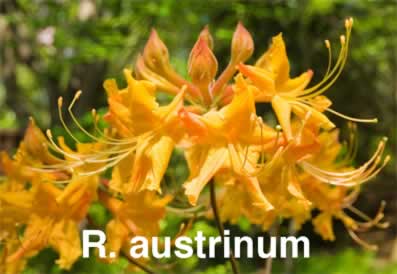 |
R. austrinum |
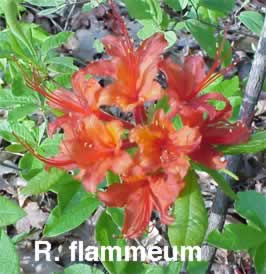 |
R. flammeum |
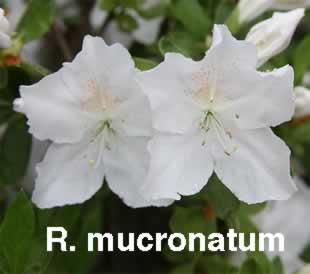 |
R. mucronatum |
R. austrinum, the Florida Azalea, is a deciduous azalea found from northwest Florida to Georgia, Alabama and southeast Mississippi. This plant blooms in early spring as the leaves are beginning to expand. The fragrant blossoms come in shades of orange through gold and yellow, and measure approximately 1 to 1.5 inches across. This species has very long stamens and the tube of the flower is often flushed with red but there is no blotch. Discovered by Dr. A. W. Chapman before 1865, R. austrinum is similar in many respects to R. canescens including the sticky glandular hairs on the flower tube, but differs in the color variations that are orange to yellow rather than pink to white. R. austrinum makes an excellent landscape plant as well as a valuable hybridizing resource, especially in southern gardens where heat tolerance is important.
R. flammeum, the Oconee Azalea (synonymous with R. speciosum ), is a deciduous azalea found in the lower Piedmont from central Georgia to South Carolina. It is seldom cultivated in cooler climates but does well in the southeast. Its blossoms are approximately 1.2 to 1.8 inches across and come is shades of yellowish orange, through orange to deep red. This species can be distinguished from the earlier blooming R. austrinum in that the flowers usually have a blotch, they are not fragrant, nor do they have sticky glandular hairs on the corolla tube. Exact date of discovery for R. flammeum is not known, but plants of this species were first described by Aiton at Kew Gardens in 1789 and were probably sent there by William Bartram prior to that date. This species is a heat tolerant shrub and holds much breeding potential where hot summer stress is a problem.
R. mucronatum, the Snow azalea, has Chinese ancestry but is not found in the wild. It is commonly used for ornamental pruning, grows 6 feet high and 4 to 6 feet wide. It is hardy to Zone 5, -15 F. Its many branches are densely covered with oval evergreen leaves, 1 1/2 to 2 1/2 inches long, matted with hairs. Its fragrant white flowers, 1 to 3 inches wide, often bloom in pairs and may be stained with green, lilac or pink at the base, depending on the variety. [Return to List]
Heat Tolerant Hybrid Azaleas
Hybrid Deciduous Azaleas Hybrid Evergreen Azaleas
Heat Tolerant Deciduous Azaleas
Aromi Hybrids Other Hybrids
Heat Tolerant Aromi Hybrid Deciduous Azaleas
The Aromi azalea hybrids were created in Mobile, Alabama by Dr. Gene Aromi, a retired education professor at the University of Southern Alabama, and his wife Jane, a retired elementary school teacher. They began their hybridizing program in 1969 to develop evergreen azaleas with "large flower size, early bloom time, improved bud hardiness, compact habit, and array of flower forms, and rich colors".
In 1971 they began hybridizing Exbury azaleas with southern native species to create heat tolerant, large flowered, fragrant deciduous azaleas. Over 100 of these deciduous hybrids are named, and 8 of them are registered. They all are R. austrinum hybrids:
 |
Aromi Sunrise, Aromi |
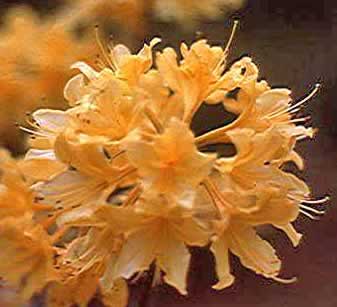 |
Aromi Sunstruck, Aromi |
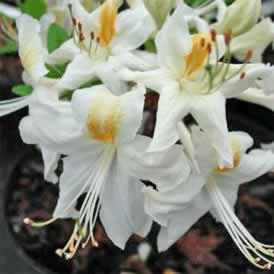 |
High Tide, Aromi |
 |
Pathfinder, Aromi |
Aromi Deciduous Azaleas were bred by Dr. Gene Aromi of Mobile, AL, for sun and heat tolerance.
Aromi Sunrise – Red orange buds open to yellow orange flowers with darker shading in the center
Aromi Sunstruck – Pale yellow buds open to lemon yellow flowers, deep yellow blotch
High Tide – Ivory with gold blotch and light pink flush petals. It has good heat tolerance. (Not Registered)
Pathfinder – Orange buds open to golden flowers, deep golden blotch [Return to List]
Other heat tolerant deciduous azaleas:
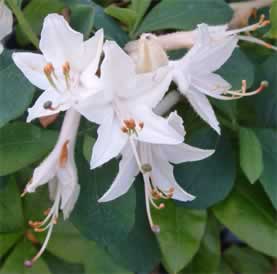 |
Fragrant Star |
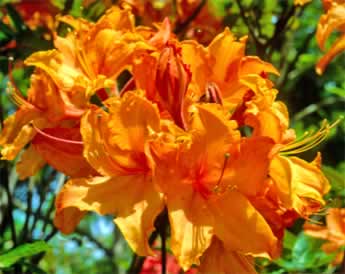 |
Tangelo |
Fragrant Star – (Briggs) – 4 ft (1.2 m), -20°F (-29°C). Extremely fragrant, snowy white flowers top lovely blue foliage like stars in the sky. The Plant has a strong, upright habit and is very heat tolerant. A must have! FRAGRANT.
Tangelo – (Greer, Exbury type) Like biting into a sweet, juicy tangelo, soft, warm orange floods the garden when this flowers. It isn’t a deep orange but a true sparkling orange that radiates. Vigorous and easy to grow, it should be hardy to at least -25°F (-32°C),, so you don’t have to worry about its durability. Stands sun and heat. [Return to List]
Heat Tolerant Evergreen Azaleas
Southern Indica Azaleas R. mucronatum Clones
Southern Indian (Indica) Hybrids – Sun Azaleas
This hybrid group was developed from a large collection of Belgian Indian hybrids in the Southeastern US around 1870. It is a mixed group, including forms and hybrids of R. indicum X R. simsii and 'Mucronatum' forms X R. indicum. Early bloomers are usually more upright and vigorous, while later bloomers are more compact and spreading. This group is sometimes referred to as "Sun Azaleas" because of their strong sun and heat tolerance. Hardy in Zones 8-10.
Southern Indicas were developed from plants at Magnolia Plantation in Charleston, S.C. and are generally hardy to Zone 8, +15°F (-10°C). They may become 6 feet tall and 10 feet or more across after 5 to 10 years in the garden. Typical Southern Indicas, all with single blossoms having one layer of petals, are 'Brilliant', red; 'Duc de Rohan', salmon pink; 'Fielder's White', snow white; 'Prince of Wales', cherry red; ´Formosa´, (deep magenta-purple flowers); ´George Lindley Tabor´, (white flowers with purplish-pink blotch and purple throat); ´Delaware Valley White´, (pure white flowers with ruffled petals); and 'Southern Charm', deep rose pink. For hardiness: 'Formosa', also called 'Phoenicia', lavender, is hardy to Zone 6, -5°F (-21°C).
Southern Indica Azaleas
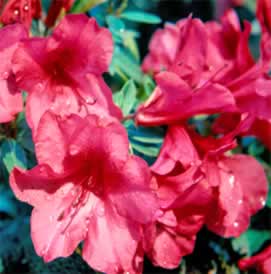 |
Brilliant |
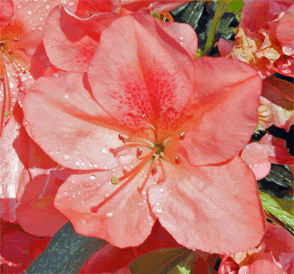 |
Duc de Rohan |
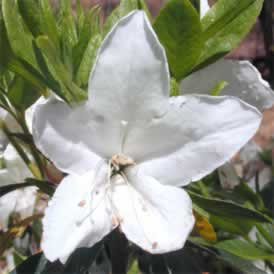 |
Fielder's White |
 |
Formosa |
Brilliant – 2 ft (.6 m), 0°F (-18°C). Has small, bright red, funnel shaped flowers that are held above smooth, green leaves. After flowering, it has bronzy-red new growth. The open growth habit does make an enjoyable plant. It is said to be tolerant of both heat and lime but will be happiest if given some shade.
Duc de Rohan – 3 ft (.9 m), 10°F (-12°C). Blooms in early mid-season. Medium height.
Fielder's White – – 5 ft (1.5 m), 5°F (-15°C). Blooms in early mid-season. Has a spreading plant habit. Medium height.
Formosa (Phoeniceum) – 5 ft (1.8 m), 10°F (-12°C). Blooms in mid-season. Has a tall upright plant. [Return to List]
More Southern Indica Azaleas
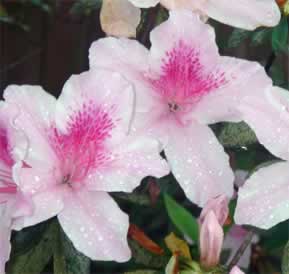 |
George Lindley |
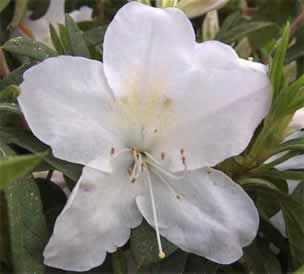 |
Mrs. G. G. |
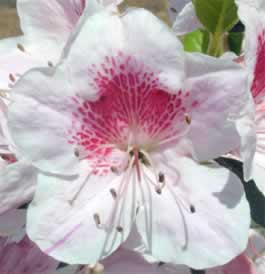 |
Iveryana |
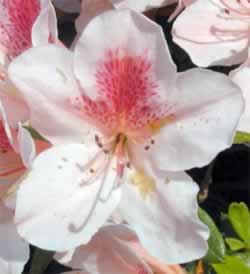 |
Pink Lace |
George Lindley Taber – – 5 ft (1.5 m), -5°F (-21°C). Blooms in mid-season. Medium height.
Mrs. G. G. Gerbing – – 3 ft (.9 m), 10°F (-12°C). Blooms in mid-season. Medium height.
Iveryana – – 2 ft (.6 m), 10°F (-12°C). Blooms late. Low plant.
Pink Lace – – 3 ft (.9 m), 0°F (-18°C). Blooms in early mid-season. Branches vigorously. Medium height. [Return to List]
More Southern Indica Azaleas
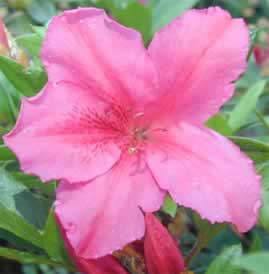 |
Pride Of Dorking |
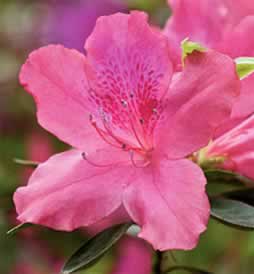 |
Pride Of Mobile |
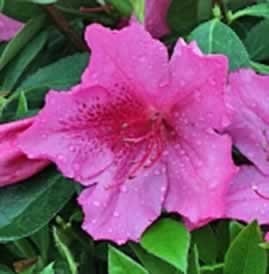 |
Southern Charm |
 |
White Lace |
Pride Of Dorking – – 5 ft (1.5 m), 10°F (-12°C). Late blooming. Medium height.
Pride Of Mobile (Elegans Superbum) – Blooms in mid-season. Has a tall upright plant.
Southern Charm – – 3 ft (.9 m), 10°F (-12°C). Blooms in mid-season. Has a tall upright plant.
White Lace – Vigorous plant habit. [Return to List]
R. mucronatum clones
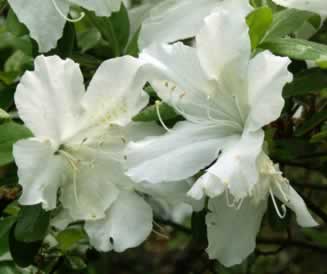 |
Delaware Valley |
 |
Ho-Oden |
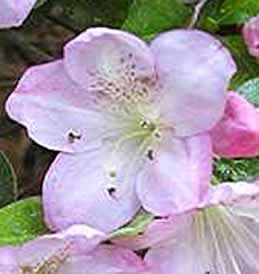 |
Lady Lilac |
Delaware Valley White – – 5 ft (1.8 m), 0°F (-18°C). Blooms in early mid-season..
Ho-Oden – Blooms in early mid-season. Hardy to 5°F (-15°C).
Lady Lilac – Blooms in early mid-season. Hardy to 5°F (-15°C). [Return to List]
How To Grow Rhododendrons and Azaleas
All rhododendrons thrive in a cool, moist, acid soil. Plant them in spring or fall where winter damage is no hazard; otherwise, plant them only in spring, setting the balled-and-burlapped root balls in the soil no deeper than 12 inches. Do not fertilize at the time of planting, as this might injure the roots, but water deeply. Supplemental feeding later is not normally needed, but if a plant appears pale or droopy, apply cottonseed meal or a fertilizer for acid-loving plants around its base in early spring. A year-round mulch of rotted oak leaves will also provide natural nutrients and will help keep the soil cool and moist.
Do not cultivate around the shallow roots of rhododendrons and azaleas, but pinch off their faded flowers to improve bloom the following year. Also, prune out dead, diseased or damaged branches, and cut old branches back to the soil level to encourage new growth.
Rhododendrons may be propagated from stem cuttings of new growth taken in late summer and rooted in a mixture of perlite or vermiculite and peat moss. For deciduous azaleas, cuttings may need bottom warmth of 75°F (24°C) and artificial light to promote root growth.
References
- Cox, Kenneth (2005). Rhododendrons & Azaleas, A Colour Guide. The Crowood Press.
- Cox, Peter, Cox, Kenneth (1997). Encyclopedia of Rhododendron Species. Glendoick Publishing.
- Salley, Homer & Greer, Harold (1986). Rhododendron Hybrids – A Guide To Their Origins. Timber Press.
- Greer, Harold E. (1996). Greer's Guidebook To Available Rhododendrons. Offshoot Publications.
